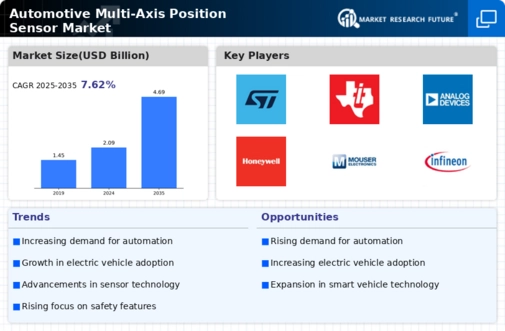The Automotive Multi-Axis Position Sensor Market has been experiencing significant growth as automotive technologies continue to evolve towards greater automation and precision. Multi-axis position sensors play a critical role in various applications, including steering, braking, and suspension systems, by providing accurate positioning information.
The competitive landscape is shaped by numerous players who are striving to enhance their market presence through innovative product offerings, strategic partnerships, and advancements in sensor technologies.
Factors such as the increasing demand for improved vehicle performance, safety, and advanced driver-assistance systems are compelling manufacturers to focus on developing more sophisticated sensor solutions. Overall, the market dynamics reflect a combination of existing market leaders and emerging players, all vying to capture a share of this expanding sector.
Ametek stands out in the Automotive Multi-Axis Position Sensor Market due to its strong emphasis on research and development, enabling it to deliver highly reliable and precise sensor solutions. The company's extensive experience in electronics and sensors allows it to leverage innovative technologies, ensuring its products meet the rigorous demands of the automotive sector.
Ametek's commitment to quality and customer satisfaction has strengthened its market position, allowing it to foster long-term relationships with key automotive manufacturers. The company also benefits from a robust distribution network and a solid brand reputation, which enhances its capability to serve a diverse range of clients.
Furthermore, Ametek's strategic investment in new technologies and continuous product development positions it favorably as the industry shifts towards electrification and advanced vehicle systems.
STMicroelectronics is recognized for its strong technological expertise and comprehensive product portfolio in the Automotive Multi-Axis Position Sensor Market. The company focuses on integrating advanced semiconductor technologies and sensor functionalities, which enables it to provide high-performance solutions tailored to automotive applications.
STMicroelectronics is noted for its commitment to innovation, with a significant portion of its resources devoted to research and development initiatives that drive the advancement of multi-axis position sensor technologies.
This strategic approach has allowed the company to maintain a competitive edge in performance, efficiency, and reliability.
By collaborating with automotive OEMs and key industry players, STMicroelectronics enhances its market presence while addressing the growing demand for smart and efficient automotive systems. Through its operations, the company remains an influential player in shaping the future of vehicle technologies.























Leave a Comment